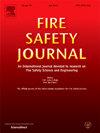Crowd management employing nudge theory for safe elevator use by people with mobility limitations during a high-rise building evacuation
Abstract
Many countries have implemented regulations or guidance concerning the use of elevators solely for people with mobility limitations for evacuation during fires. However, there is uncertainty regarding whether people without disabilities may want to use the elevators during an emergency, which could lead to inoperability of the elevators or crowd accidents. This research conceptualized a nudge solution that can reduce the undesirable motivation of people without disabilities to try to use elevators solely for people with mobility limitations. The solution is based on an ordinary phased-evacuation strategy and was assessed experimentally. Twenty-five participants who were fire safety professionals were gathered in a 47th-floor meeting room of a 50-story building. They were instructed to evacuate to the nearest staircase/elevator lobby where a wheelchair user was waiting for rescue by elevator. The participants were immersed in four virtual cases that replicated the evacuation behavior of other people without disabilities in the actual lobby. The results showed that reducing the queuing and wait time in the lobby by phased evacuation can reduce the motivation of people without disabilities to use the elevator. An ordinary phased-evacuation for crowd management can also contribute to safe elevator use by people with mobility limitations.

 求助内容:
求助内容: 应助结果提醒方式:
应助结果提醒方式:


